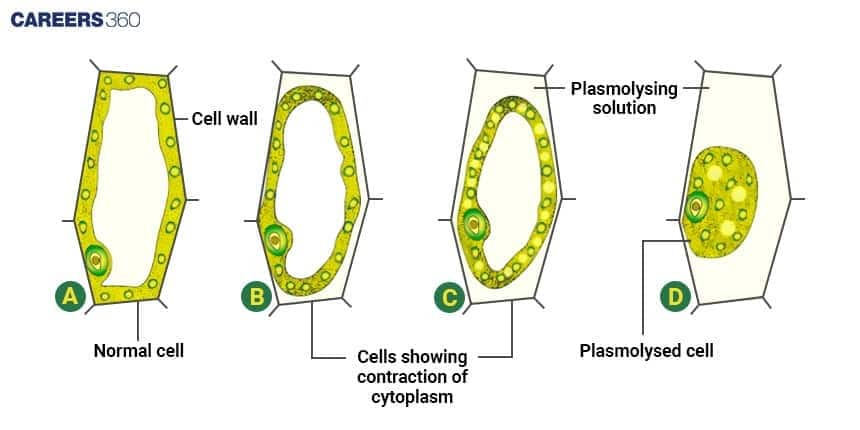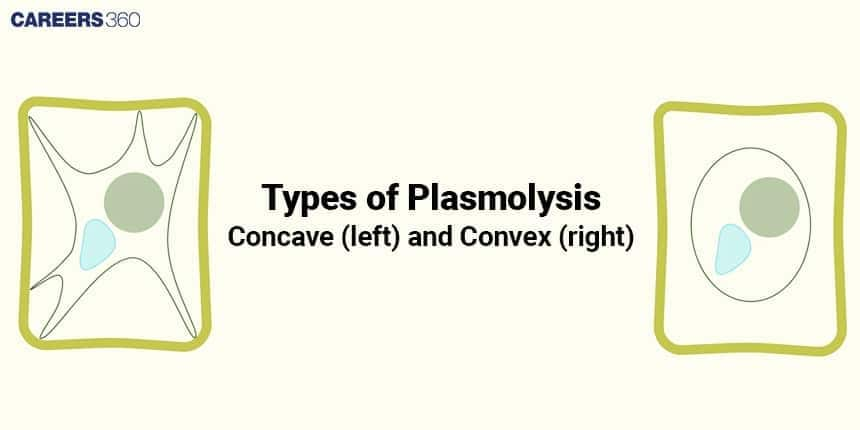Plasmolysis and Deplasmolysis: Definition, Purposes & Examples, Process, Types
Plasmolysis is the shrinkage of a plant cell’s protoplasm when placed in a hypertonic solution, causing water to exit the cell. Deplasmolysis is the reverse process, where water enters a plasmolysed cell in a hypotonic solution, restoring its turgidity. Together, they explain osmosis and cellular water regulation.
This Story also Contains
- What is Plasmolysis?
- Stages of Plasmolysis
- Types of Plasmolysis
- Examples of Plasmolysis
- What is Deplasmolysis?
- Difference Between Plasmolysis and Deplasmolysis
- Plasmolysis and Deplasmolysis NEET MCQs (With Answers & Explanations)

What is Plasmolysis?
Plasmolysis is the contracted state of protoplasm in a plant cell due to loss of water. It occurs when plant cells are placed in a hypertonic solution and causes the water to rush out of the cell, peeling the cell membrane away from the cell wall. The phenomenon of plasmolysis clarifies the effects of osmotic pressure on plant cells. It rarely occurs naturally.
Stages of Plasmolysis
Plasmolysis takes several successive steps, accompanied by distinct changes in the cell structure. These changes occur during plasmolysis:
Incipient Plasmolysis
The outflow of water from the cell sets in, hence the cell starts to shrink. The cell wall is still intact while the volume of the cell decreases, due to which the cell wall appears more prominent.
Evident Plasmolysis
In this stage, the cell wall is maximally contracted. The cytoplasm starts detaching from the cell wall and becomes roughly spherical as the protoplasm withdraws further.
Final Plasmolysis
The cytoplasm is completely separated from the cell wall in the final stage and centrally lies in a cell. This appears to be a shrunk cell detached from the cell wall.

Types of Plasmolysis
But plasmolysis can be classified based on the final shape taken by the cytoplasm as the process ends:
Concave Plasmolysis
In concave plasmolysis, the plasmalemma and protoplasm contract and get separated from the cell wall. However, they do not collapse completely. This type of plasmolysis is reversible, meaning it can be reversed by putting the cell in a hypotonic solution, which will permit water to reenter the cell.
Convex Plasmolysis
The plasmalemma and protoplasm are completely detached from the cell wall in this case. Collapse of the cell wall takes place, causing cell destruction. The process is irreversible and is the cause of the death of a plant due to the loss of an extreme amount of water.

Examples of Plasmolysis
Plasmolysis takes place in several practical instances, including:
Shrinkage of vegetables in hypertonic solutions.
Shrinkage of blood cells in hypertonic conditions
Salt deposition from coastal flooding.
Weedicides kill weeds in farms.
Food preservation in high salt concentrations arresting the growth of microorganisms.
What is Deplasmolysis?
Deplasmolysis is when a plasmolysed cell is placed in a hypotonic solution. It re-enters the cell and it swells and regains its turgidity. In an isotonic solution, the cell will be in a state of equilibrium. There will be no net movement of water in an isotonic solution, flaccid.
Mechanism
It takes place when the cell is placed in the hypotonic solution with a lower solute concentration outside the cell.
Water moves into the cell through the osmotic movement, from a region of lower solute concentration to a higher concentration inside the cell.
This increases the protoplast size by pushing against the wall and causing turgidity.
Conditions Required
Presence of a hypotonic environment, which includes fresh water.
The process reverses only if the cell wall remains intact during plasmolysis.
Active metabolic processes in the cell may help the uptake of water.
Difference Between Plasmolysis and Deplasmolysis
The difference between plasmolysis and deplasmolysis is given:
Feature | Plasmolysis | Deplasmolysis |
Solution type | Hypertonic | Hypotonic |
Water movement | Out of cell | Into cell |
Protoplast condition | Shrinks and detaches | Expands and reattaches |
Turgor pressure | Decreases | Increases |
Cell condition | Flaccid | Turgid |
Example | Vegetable shrinkage in salt | Rehydration of wilted plant |
Plasmolysis and Deplasmolysis NEET MCQs (With Answers & Explanations)
Important topics for NEET exam are:
Stages of Plasmolysis
Types of Plasmolysis
Plasmolysis vs Deplasmolysis
Practice Questions for NEET
Q1. Why can gargle with salt water help cure a bacterial infection?
The salt creates an isotonic environment, where bacteria can no longer control the flow of water into or out of the cell.
The salt creates a hypertonic environment, causing bacteria to swell with water and burst.
The salt creates a hypotonic environment, causing bacteria to undergo plasmolysis and die.
The salt creates a hypertonic environment, causing bacteria to undergo plasmolysis and die
Correct answer: 4) The salt creates a hypertonic environment, causing bacteria to undergo plasmolysis and die
Explanation:
Adding salt or sugar to water creates a hypertonic solution that forces the water out of the cells, into the outer environment through osmosis. This results in partial dehydration of the cells and is termed plasmolysis. The cell's normal functioning is interrupted, and its multiplication is hampered by this process, hence making it an excellent method of food preservation as well as an inhibitor of microbial growth.
Hence, the correct answer is option 4) The salt creates a hypertonic environment, causing bacteria to undergo plasmolysis and die.
Q2. What will happen if a plasmolysed cell is placed in a hypotonic solution?
Continuation of evident plasmolysis
Continuation of incipient plasmolysis
Endosmosis of water
Equilibirum is achieved
Correct answer: 3) Endosmosis of water
Explanation:
When a plasmolysed cell is kept in a hypotonic solution, it will regain its original shape and this process is called deplasmolysis. When a plasmolysed cell is kept in a hypotonic solution, it will regain its original shape, and this process is called deplasmolysis. During deplasmolysis, water enters the cell by osmosis, causing the cytoplasm to expand and pushing the plasma membrane back against the cell wall. This reverses the effects of plasmolysis, where the cell shrinks due to water loss in a hypertonic solution. Deplasmolysis is a vital process for the restoration of cell turgidity in plant cells.
Hence, the correct answer is option 3) Endosmosis of water.
Q3. What is plasmolysis?
The process of water flowing out of cells in a hypotonic solution.
The process of water flowing in and out of cells at an equal rate in an isotonic solution.
The process of water flowing out of cells in a hypertonic solution
The process of water flowing in cells in a hypotonic solution.
Correct answer: 3) The process of water flowing out of cells in a hypertonic solution
Explanation:
Plasmolysis is the process in which the protoplasm of a plant cell contracts and pulls away from the cell wall due to the loss of water through exosmosis. This occurs when the cell is placed in a hypertonic solution, where the concentration of solutes outside the cell is higher than inside, causing water to flow out of the cell. On the other hand, the process of water flowing into cells when they are placed in a hypotonic solution (where the concentration of solutes outside the cell is lower than inside) is called turgor pressure or endosmosis. In this case, water moves into the cell, causing it to swell and become turgid.
Hence, the correct answer is option 3) The process of water flowing out of cells in a hypertonic solution.
Also Read:
Frequently Asked Questions (FAQs)
The concave plasmolysis is a partial detachment of protoplasm from the cell wall and thus is reversible. Convex plasmolysis is complete detachment and cell wall collapse; thus, it is irreversible.
Naturally, plasmolysis is quite a rare event, but it still can take place in plants under very stressful conditions that cause them to lose much water, as in the case of drought or high salt concentrations.
That is, the plant cells lose water from the cell and protoplasm contracts on being placed in a hypertonic solution. This causes plasmolysis.
Plasmolysis can be reversed by placing the plasmolyzed cell in a hypotonic solution, whereby the water will reenter the cell and restitute back its turgidity.
The stages of plasmolysis are incipient plasmolysis, evident plasmolysis, and final plasmolysis.